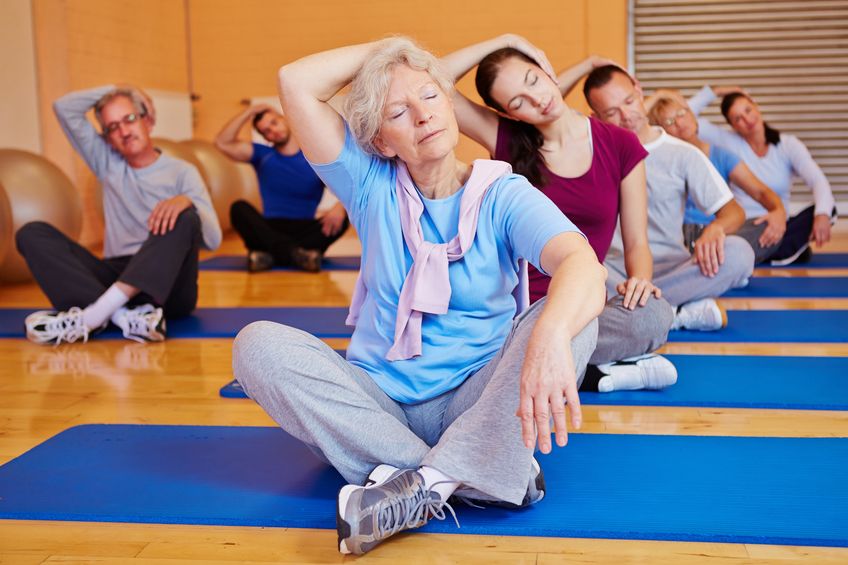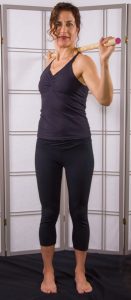Last updated on January 17th, 2019
Exercises to Improve Neck Stiffness (Range of Motion)

Neck Stiffness
Neck stiffness can be a debilitating feeling. National Institute of Health Statistics survey revealed neck pain as 3rd most common type of pain reported by Americans. As neck stiffness or pain is a warning sign that attention is needed, it is also a indication of the presence of poor posture.
Posture & Neck Stiffness

There is a reciprocal relationship between the neck and the lower spine. They both should have a healthy “c” shaped curve with the convexity toward the front. The healthy curves of the spine are a foundation of a balanced, symmetrical upright posture. Having these healthy “c” curves then allows for healthier posture in motion.
When there is a loss of motion due to stiffness in the neck there is generally a loss of the “c” shape curve. The body compensates by changing the rest of the spine below. The resulting compensation can be seen as poor posture.
What is Neck Stiffness?
Every joint in our body has been assigned degrees of “normal” movement referred to as “range of motion”. It’s a base line to let us know whether that joint has proper function. Neck stiffness could be an indication that one or more joints are malfunctioning. There are some serious conditions that ought to be considered – please see your health care practitioner to rule them out. Barring a serious condition neck stiffness is commonly a sign of inflamation, loss of joint motion, muscular restriction, and nerve impingment.
Measuring Range of Motion
The neck has its assigned range of motion degrees. The most common way to measure range of motion clinically is through observation using various hand-held devices or digital devices. While at home, evaluation can include checking for symmetry and movement that feels like you’re getting a full range without pain. Call on a friend or family member to help you. Have them watch you while you perform the ranges of motion as listed below.
Start with turning your head from side to side – this is rotation. Nodding your head down so you chin goes to your chest and then lifting your head up towards the ceiling is flexion and extension. To check lateral flexion keep your shoulders relaxed and bring the same side ear to the same side shoulder – do this for each side. Each of those movements have scientific terms and relatively agreed upon degrees of movement that are considered “normal”. Here is a list of what is accepted as normal range of motion for an adult neck:
Rotation – Left (turning head to left side) – 80 degrees
Rotation – Right (turning head to right side) – 80 degrees
Flexion (chin to chest) – 60 degrees
Extension (chin up towards ceiling) – 50 degrees
Lateral Flexion -Left (Left ear to left shoulder) – 40 degrees
Lateral Flexion -Right (Right ear to left shoulder) – 40 degrees
Improve Neck Stiffness Immediately
When I first implemented these exercise (see below) to improve stiffness of the neck, I was shocked by the immediate results. These exercises work because you use larger muscle groups and greater mass to create the same movement as if you were making the same movement with your head. Keep your head still and let your body move around it. Therefore, find a spot on a wall to focus your eyes on. Also using a pole or exercise band is helpful in keeping your body square.
Rotation
Rotate your body from side to side and go to each side 20 times.


Flexion/extension
In one slow gentle motion bend forward then arch gently back. Keep your eyes looking forward. Go front and back 20 times.


Lateral Flexion
Bend your body from side to side and go to each side 20 times.


How often?
My clients do these exercises everyday at least once per day. It not only relieves neck stiffness it also improves neck range of motion. Furthermore be sure to take your time and do each movement slowly, avoiding anything that brings discomfort. Because of benefits of these exercises, I include them as part of my patient exercise routines. Consequently, I have been giving clients these for years and I know that they will bring you as much benefit as I have seen in my office.

Dr. Paul Paez, DC, NRT, NET, CMT
National Board Certified Doctor of Chiropractic (DC), trained in clinical nutrition (NRT), neuro-emotional release (NET), and Massage Therapy (CMT). Dr. Paul holds the rare triple distinction of Certified Posture Expert, Certified Posture Neurologist and Certified Posture Ergonomist by the American Posture Institute. Posture Possible is the very best resource for posture information.



